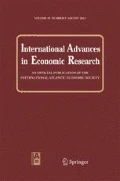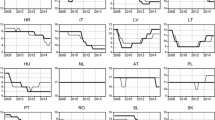Abstract
This paper asks whether rating agencies played a passive role or were an active driving force during Europe’s sovereign debt crisis. We address this by estimating relationships between sovereign debt ratings and macroeconomic and structural variables. We then use these equations to decompose actual ratings into systematic and arbitrary components that are not explained by previously observed procedures of rating agencies. Finally, we check whether systematic, as well as arbitrary, parts of credit ratings affect credit spreads. We find that both do affect credit spreads, which opens the possibility that arbitrary rating downgrades trigger processes of self-fulfilling prophecies that may drive even relatively healthy countries towards default.

Similar content being viewed by others
Notes
Our sample includes Australia, Austria, Belgium, Canada, Czech Republic, Denmark, Finland, France, Germany, Greece, Hungary, Iceland, Ireland, Italy, Japan, Netherlands, New Zealand, Norway, Poland, Portugal, South Korea, Spain, Sweden, Switzerland, United Kingdom, and the USA.
Data for 2010 are mostly estimates provided by the OECD Economic Outlook or the IMF World Economic Outlook database.
Since the data needed for our analysis were not available for all three agencies we settled for Fitch as a representative. Given the high correlation between the ratings of Fitch and Standard & Poor’s we do not expect this choice to bear on our main results.
Due to the high volatility of daily data we used December averages instead of the December 31st value for the end-of-year values.
Note that this must not be confused with the question whether a country actually declares default or not, see Eaton et al. (1986).
In fact, high values of government effectiveness seem to be a result rather than a cause of high income levels, since this index comprises elements like the quality of infrastructure, public schooling or public health care.
Afonso et al. (2009) also find a negative effect of income growth on sovereign debt ratings.
A Hausman Test strongly indicates the use of fixed effects rather than random effects.
We can do so since the underlying data series—government bond yields and sovereign debt ratings—are available on a daily basis.
As mentioned before, the credit spread of a country denotes the difference between its government bond yield and that of Germany. The rating spread denotes the difference between Germany’s rating and the respective country’s rating. Since Germany obtains a AAA rating in all observations, the rating spread is the distance of the current rating to the maximum rating.
Reisen and von Maltzan (1999) find similar results using Granger causality tests. However, they apply a slightly different method and use different data.
Both ratings and credit spreads are now end of year values.
Note that the rating markup for the PIGS countries during the crisis is always negative and actually represents a markdown.
Or that rating agencies use a model that economic theory has not deciphered yet.
Note the negative coefficients: A markdown or negative markup therefore leads to higher credit spreads.
Note that, as expected, the signs of the coefficients are opposite to the ones before, since higher credit spreads match with lower ratings. Also note that including \( {\overset{\lower0.5em\hbox{$\smash{\scriptscriptstyle\frown}$}}{R}}_{{i,t}}^X \) in this regression results in multicollinearity, as expected.
Compared to standard OLS, coefficients are virtually identical and significance levels are very much the same. Only the significance level of the PIGS × Crisis markup drops slightly from 99% to 95% when bootstrapping is applied.
References
Afonso, A., Gomes, P., & Rother, P. (2007). What ‘hides’ behind sovereign debt ratings? ECB Working Paper Series, No. 711, January.
Afonso, A., Gomes, P., & Rother, P. (2009). Ordered response models for sovereign debt ratings. Applied Economics Letters, 16(8), 769–773.
Attinasi, M.-G., Checherita, C., & Nickel, C. (2009). What explains the surge in Euro area sovereign spreads during the financial crisis of 2007–09? ECB Working Paper Series, No. 1131, December.
Becker, W. E., & Kennedy, P. E. (1992). A graphical exposition of the ordered probit. Econometric Theory, 8, 127–131.
Block, S., & Vaaler, P. M. (2004). The price of democracy: sovereign risk ratings, bond spreads and political business cycles in developing countries. Journal of International Money and Finance, 23, 917–946.
Cantor, R., & Packer, F. (1996). Determinants and impact of sovereign credit ratings, Federal Reserve Bank of New York. Economic Policy Review, 2(2), 37–53.
Crotty, J. (2009). Structural causes of the global financial crisis: a critical assessment of the ‘new financial architecture’. Cambridge Journal of Economics, 33, 563–580.
Eaton, J., Gersovitz, M., & Stiglitz, J. E. (1986). The pure theory of country risk. European Economic Review, 30, 481–513.
Eichengreen, B., & Mody, A. (2000). What explains changing spreads on emerging-market debt? In: S. Edwards (Eds.) Capital flows and the emerging economies: theory, evidence, and controversies (pp. 107–136). University of Chicago Press.
El-Shagi, M. (2010). The role of rating agencies in financial crises: event studies from the asian flu. Cambridge Journal of Economics, 34, 671–685.
Ferri, G., Liu, L.-G., & Stiglitz, J. E. (1999). The procyclical role of rating agencies: evidence from the east asian crisis. Economic Notes, 28(3), 335–355.
Gomez-Puig, M. (2006). Size matters for liquidity: evidence from EMU sovereign yield spreads. Economics Letters, 90(2), 156–162.
Goodhart, C. A. E. (2008). The background to the 2007 financial crisis. International Economics and Economic Policy, 4(4), 331–346.
Hu, Y.-T., Kiesel, R., & Perraudin, W. (2002). The estimation of transition matrices for sovereign credit ratings. Journal of Banking & Finance, 26, 1383–1406.
Kamin, S. B., & von Kleist, K. (1999). The evolution and determinants of emerging market credit spreads in the 1990s. BIS Working Papers, No. 68, May.
Manganelli, S., & Wolswijk, G. (2009). What drives spreads in the euro area government bond market? Economic Policy, 24(4), 191–240.
Mellios, C., & Paget-Blanc, E. (2006). Which factors determine sovereign credit ratings? European Journal of Finance, 12(4), 361–377.
Mulder, C., & Perrelli, R. (2001). Foreign currency credit ratings for emerging market economies. IMF Working Paper, No. 191.
Reisen, H., & von Maltzan, J. (1999). Boom and bust and sovereign ratings. International Finance, 2(2), 273–293.
Sgherri, S., & Zoli, E. (2009). Euro area sovereign risk during the crisis. IMF Working Paper, No. 222.
Author information
Authors and Affiliations
Corresponding author
Additional information
We are grateful to Andreas Kleiner, Simon Knaus and Giovanni Mellace for many helpful comments and suggestions.
Rights and permissions
About this article
Cite this article
Gärtner, M., Griesbach, B. & Jung, F. PIGS or Lambs? The European Sovereign Debt Crisis and the Role of Rating Agencies. Int Adv Econ Res 17, 288–299 (2011). https://doi.org/10.1007/s11294-011-9302-7
Published:
Issue Date:
DOI: https://doi.org/10.1007/s11294-011-9302-7




